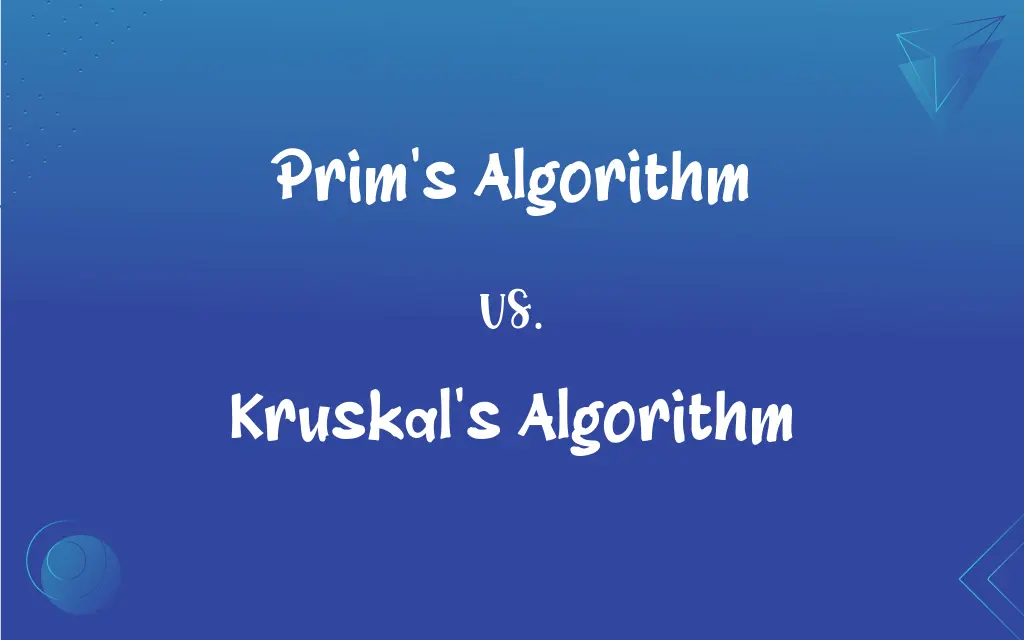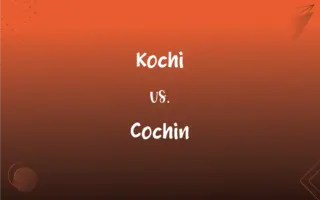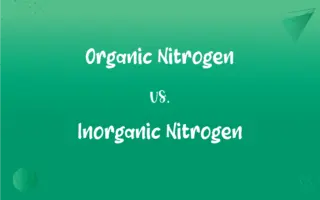Prim’s Algorithm vs. Kruskal’s Algorithm: What's the Difference?
Edited by Aimie Carlson || By Janet White || Published on March 28, 2024
Prim's algorithm builds a minimum spanning tree by adding adjacent vertices; Kruskal's algorithm does so by selecting the shortest edges without forming cycles.

Key Differences
Prim’s algorithm starts from a single vertex and grows the minimum spanning tree by adding the nearest adjacent vertex to the tree. Kruskal’s algorithm, in contrast, builds the minimum spanning tree by selecting the shortest edge in the graph that doesn’t form a cycle with the already included edges. This fundamental approach difference affects how the algorithms operate on the graph.
In Prim’s algorithm, the process is vertex-centric, meaning it considers the vertices and the edges that connect to the already chosen vertices. Kruskal’s algorithm is edge-centric; it examines all the edges and selects them based on their weight, irrespective of the vertices, until the spanning tree is complete.
Prim’s algorithm can be more efficient in dense graphs where the number of edges is high, as it iteratively adds adjacent vertices. Kruskal’s algorithm can be more efficient in sparse graphs, where the number of edges is lower compared to the number of vertices, as it selects the shortest edges globally.
The implementation of Prim’s algorithm often uses data structures like priority queues, which can lead to efficient handling of the vertices and edges. Kruskal’s algorithm frequently employs disjoint-set data structures to keep track of the connected components and ensure no cycles are formed.
Prim’s and Kruskal’s algorithms are both greedy algorithms, meaning they make the local optimal choice at each step with the hope of finding a global optimum. However, their application varies based on the structure of the graph and the specific requirements of the problem at hand.
ADVERTISEMENT
Comparison Chart
Approach
Vertex-centric, adding nearest adjacent vertices
Edge-centric, selecting shortest edges
Efficiency in Graph Type
More efficient in dense graphs
More efficient in sparse graphs
Data Structures Used
Priority queues
Disjoint-set data structures
Cycle Handling
Inherent in vertex addition
Managed using disjoint-set
Suitability
Preferred for graphs with lots of edges
Better for graphs with fewer edges
ADVERTISEMENT
Prim's Algorithm and Kruskal's Algorithm Definitions
Prim's Algorithm
Starts from a single vertex and expands.
In the algorithm, starting from the city center, Prim’s method was applied to extend roads.
Kruskal's Algorithm
Suitable for sparse graphs.
For the wide-spread rural network, Kruskal’s algorithm provided an effective solution.
Prim's Algorithm
Uses priority queues for implementation.
To manage the growing tree efficiently, Prim’s algorithm utilized a priority queue.
Kruskal's Algorithm
Builds a minimum spanning tree by selecting the shortest edges.
Kruskal’s algorithm was employed to design the efficient layout of pipelines across the fields.
Prim's Algorithm
Grows a minimum spanning tree by adding adjacent vertices.
Prim’s algorithm was used to find the least costly network of roads in the new city plan.
Kruskal's Algorithm
Edge-centric approach without forming cycles.
Kruskal’s method ensured no loops were formed in the power grid layout.
Prim's Algorithm
Efficient for dense graphs.
Given the complex network, Prim’s algorithm quickly found the optimal solution.
Kruskal's Algorithm
Focuses on global edge choices for optimal tree.
Kruskal’s algorithm selected edges ensuring the shortest connections throughout the network.
Prim's Algorithm
Makes optimal local choices for a global solution.
Prim’s algorithm selected the closest node at each step to minimize overall costs.
Kruskal's Algorithm
Utilizes disjoint-set data structures.
To manage the various connections, Kruskal’s algorithm used a disjoint-set.
FAQs
What is Prim's algorithm?
A method to build a minimum spanning tree by adding adjacent vertices.
When is Prim's algorithm more efficient?
In dense graphs with many edges.
When should Kruskal's algorithm be used?
In sparse graphs with fewer edges.
How does Prim's algorithm handle cycles?
It inherently avoids cycles by adding adjacent vertices.
What is Kruskal's algorithm?
A technique to construct a minimum spanning tree by choosing the shortest edges.
What data structure is essential for Kruskal's algorithm?
Disjoint-set data structures.
How does Kruskal's algorithm ensure no cycles?
Using disjoint sets to keep track of connected components.
What data structure does Prim's algorithm use?
Primarily priority queues.
Can Prim's algorithm start from any vertex?
Yes, it can start from any vertex in the graph.
Can Prim's algorithm be used for directed graphs?
It's typically used for undirected graphs.
How does Kruskal's algorithm deal with edge weights?
It selects edges in order of increasing weight.
Are both algorithms used for network routing?
Yes, both are used in network design and routing.
Can both algorithms give different results?
They may differ in approach but yield the same minimum spanning tree for a given graph.
What is a significant benefit of Kruskal's algorithm?
Its simplicity and effectiveness in sparse graphs.
How does Prim's algorithm select the next vertex?
Based on the shortest edge connecting to the tree.
Is Prim’s algorithm a greedy algorithm?
Yes, it makes the optimal choice at each step.
What is a key advantage of Prim's algorithm?
Its efficiency in handling dense graphs.
Does Kruskal’s algorithm require sorting of edges?
Yes, edges should be sorted based on weight.
Is Kruskal’s algorithm suitable for all types of graphs?
It's versatile but more efficient in sparse graphs.
Does Kruskal’s algorithm work with disconnected graphs?
It can handle disconnected components but builds the spanning tree for connected parts.
About Author
Written by
Janet WhiteJanet White has been an esteemed writer and blogger for Difference Wiki. Holding a Master's degree in Science and Medical Journalism from the prestigious Boston University, she has consistently demonstrated her expertise and passion for her field. When she's not immersed in her work, Janet relishes her time exercising, delving into a good book, and cherishing moments with friends and family.
Edited by
Aimie CarlsonAimie Carlson, holding a master's degree in English literature, is a fervent English language enthusiast. She lends her writing talents to Difference Wiki, a prominent website that specializes in comparisons, offering readers insightful analyses that both captivate and inform.







































































